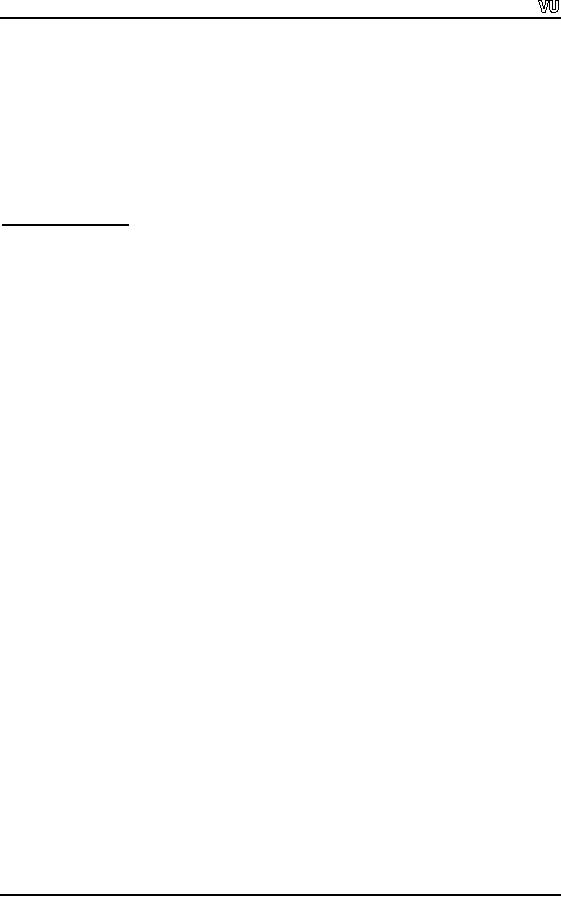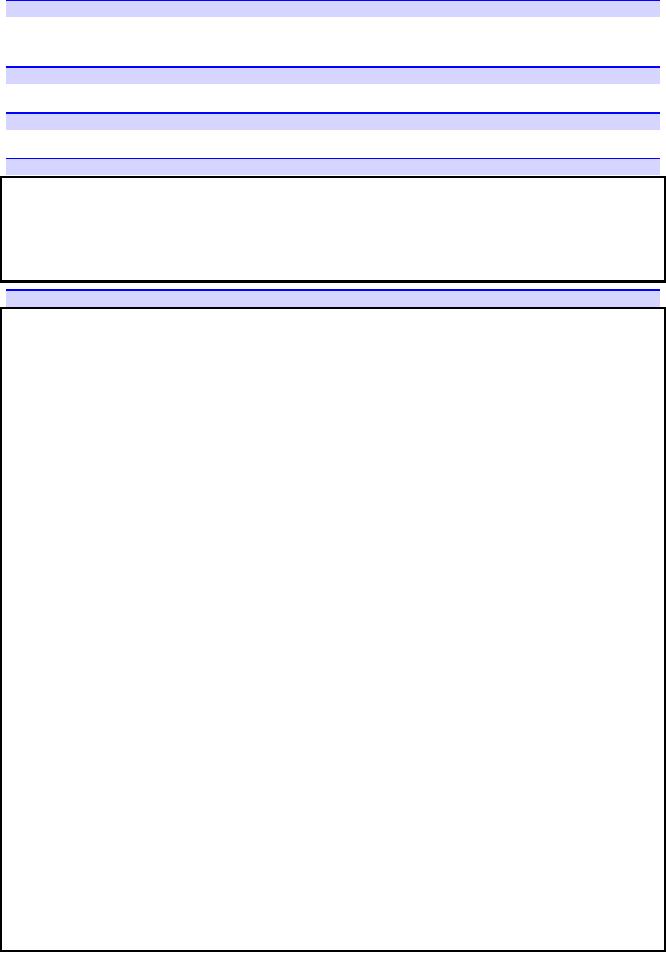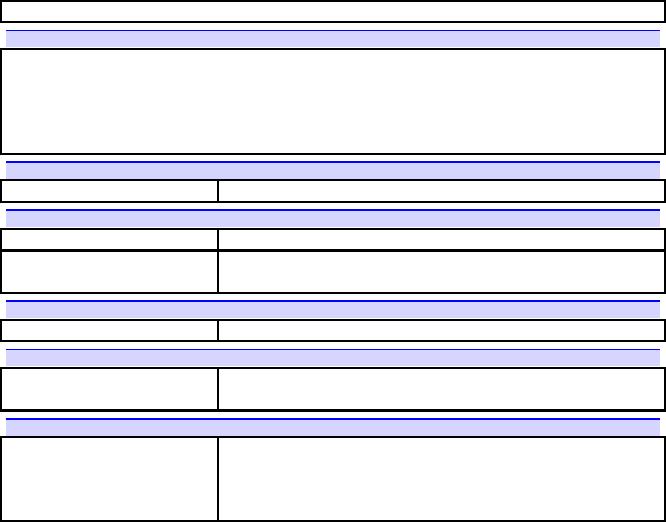 |

CS201
Introduction to Programming
Lecture
Handout
Introduction
to Programming
Lecture
No. 45
Reading
Material
Lecture
43 - Lecture 44
Summary
·
Example
(continued)
·
Assignment
Operator Function
·
Addition
Operator Function
·
Plus-equal
Operator Function
·
Overloaded
Plus Operator Function
·
Minus
Operator Function
·
Multiplication
Operator Function
·
Insertion
and Extraction Operator
Function
·
exercise
·
Rules
for Programming
·
Variables
and Pointers
·
Arrays
·
Loops and
decisions
·
Classes
and Object
·
Garbage
Collection
·
Truth
Table
·
Structured
Query Language
Example
(continued)
This is a
sequel of the discussion on
`matrix class' made in the
previous lectures.
Assignment
Operator Function
Before going
into minute details, we will
talk about the assignment
operator of this
class.
This
operator occupies very
important place in the field
of programming. When we want
to write
code like a = b;
where
a
and
b
both
are matrices, the assignment
operator attains
a
critical role as our class
does dynamic memory allocation. Here we
don't know whether
the size
of a
and
b
will be
the same or not. If these
are of different size, then it
will be
Page
587

CS201
Introduction to Programming
better to
reallocate the memory. So it warrants
the existence of some checks
and
balances.
At first, we look at the
declaration line of the
assignment operator, it is
written
below.
const
Matrix & operator = (const
Matrix &m);
The
declaration line states that
it must return a reference to a matrix.
Why do we want to
return a
matrix? The return of the
matrix is necessary to enable us
write the statement
i.e.
a = b = c;
We
know, in C and C++
languages, every expression
has a value of its
own.
Now if we
write a = b ;
it
will mean that the
whole action will have a
value. This value
itself
will be a reference to a matrix. On
the other hand, we have
made it const. In
other
words,
the reference that is being
returned is a constant.
Whenever
we return a reference of a thing
that thing can become on
left-hand side of an
assignment
statement, which can lead to
some very funny behavior. If
we write (a = b)
=
c ;
It
will result in the execution of
the statement, a = b.
It
will return a value that is
a
reference
to a matrix. This reference
will be assigned the value
of c. this
means that some
minor
things can take place. We
will like to have
parentheses only on right
hand side. It
is
advisable not to do an assignment to
the reference that is being
returned. To avoid this,
we write
const
with
it. Thus, we get the
efficiency as reference is being
returned. We also
enjoy
safety due to the fact that
no value can assign to this
reference in the same
statement.
Due to the reference
returned, we can write the
statement like a = b = c
;
Let's
have a look on the next
implication i.e. the size of the
matrix. Whenever there
is
dynamic
memory allocation in a class, we
have to check against
self-assignment. Self-
assignment
means statements like a = a
;. If
we take ordinary variables, say
integer,
writing
i = i ;
is
quiet right. But if we write something
like a = a ;
it
will be possible to
free
the memory of object on the
left hand side as it is doing
some dynamic memory
allocation.
Now we can assign new
memory and copy the right
hand side in it. If we
write
a = a;
it
will lead to a very tricky
situation. This means that
we, at first, delete it (the
left-
hand
side), as right hand side is
the same object with same
memory, so it is also
deleted.
Then, we
try to copy the right hand
side that has been
deleted. So we must check
against
self-assignment.
While dealing with the code
of the assignment operator, we
will first
check
whether it is for the self-assignment or
not. To ascertain it, we
will write the
following
line.
if(
&m != this)
This
way, the self-assignment
check has been carried
out. In case of not finding
self-
assignment,
the programmer will have to do further
process..
After
checking the self-assignment, the program
checks the size of both the
matrices and
sees
whether these are the same
or different. If their size is same, then
it will copy the
matrix of
right hand side element-by-element in
the matrix on left-hand side.
But if their
size is
different in terms of number of
rows or columns, then we have to
create a new
matrix
for the left-hand side. This
code is similar to the one
that we wrote in the
constructor.
We free the memory and
reallocate the memory of the
correct size. This size
Page
588

CS201
Introduction to Programming
is equal
to the size of the matrix on
right hand side. After
re-allocating the memory, we
readjust
the number of rows and
columns of the lef- hand
side object. So we write it as
numerous
= m.numRows ;
numCols =
m.numCols ;
While
defining rows and columns, we
execute a for
loop
and copy the elements of
right
hand
side at corresponding positions on left
hand side. This way, we
define the
assignment
operator, which can be used
in different functions. Here, we can
write
statement
like a = b
which will work
properly. The same thing is applied to
our main
code
when we come to a client
function of the class. The
code of the function
of
assignment
operator is written as
below.
const
Matrix & Matrix :: operator = (
const Matrix & m )
{
if(
&m != this)
{
if
(numRows != m.numRows || numCols !=
m.numCols)
{
delete []
elements;
elements
= new (double *)
[m.numRows];
for
(int i = 0; i < m.numRows;
i++)
elements[i]=new
double[m.numCols ];
}
numRows =
m.numRows;
numCols =
m.numCols;
for (
int i=0; i<numRows;
i++)
{
for(int
j=0; j<numCols;
j++)
{
elements[i][j]
= m.elements[i][j];
}
}
}
return
*this;
}
Addition
Operator Function
Now we
will discuss the addition
operator. We have discussed a
variety of addition
operators.
We come across one of these
while writing a + b
where
a
and
b
are
matrices.
While
adding two matrices, it is
ensured that these are
compatible. It means that
the
matrices
are conformable for addition. Their
number of rows and columns
should be
equal.
The code, we have just,
written is very simple. It
first checks whether the
matrices
are
compatible. If so, it does the
element-to-element addition. If these are
not compatible,
it
returns the old matrix. Here
the thing to remember is,
what is being returned?
The
addition
operator returns a new
matrix after adding two
matrices. The matrices,
which
Page
589

CS201
Introduction to Programming
were
added, remain the same. So,
if we add two matrices a
and
b, these
will remain as it
is and
addition operator will return a
resultant matrix by adding them.
Therefore, if we
find
the matrices are compatible, a
new matrix is defined.
Having defined the new
matrix,
we can
apply some tricks to it. We
can define the new matrix by
using copy constructor.
So a complete
matrix will be copied to it.
This is reflective from the
following statement.
Matrix
temp (m) ;
When we a copy of
one matrix, i.e. temp, the
elements of the other matrix
are added to it.
We do
this with a loop. After this, temp is
returned. This temporary matrix (temp)
which
was
created in the addition
operator, is returned. However,
its reference can not
be
returned.
Here we have to return a matrix,
ignoring the problem of efficiency. So
this
whole
matrix will be copied on the
stack and assigned wherever it is
needed. If we have
written
c = a + b
; it
will be assigned to c. The
things where the reference or matrix
is
being
returned, should be carried
out carefully. It is important
for us to know what
thing
should be
returned to where, and what is
its usage and behavior?
The code of the
addition
operator
function is written in the program as
below.
Matrix
Matrix::operator + ( Matrix &m )
const
{
// Check
for conformability
if(numRows
== m.numRows && numCols ==
m.numCols)
{
Matrix
temp(*this);
for
(int i = 0; i < numRows;
i++)
{
for
(int j = 0; j < numCols;
j++)
{
temp.elements[i][j]
+= m.elements[i][j];
}
}
return
temp ;
}
Matrix
temp(*this);
return
temp;
}
Plus-equal
(+=) Operator
Function
Now we
will discuss the +=
operator. Whenever a programmer writes
a +=
b, he
will
come
across a different scenario as
compared to the one
witnessed in the case of
the
addition
operator. In a way, now `a'
itself is
being changed. So if a
is
going to change,
we can
return a reference to a. The
conformability check remains
the same as in ordinary
addition.
That means both matrices must
have the same number of
rows and columns.
There is
no need of creating a temporary matrix.
Here we can return reference to
left-
hand
side matrix. Here one finds
that there is reuse and
efficiency in the code. The
+=
operator
is defined as under.
Page
590

CS201
Introduction to Programming
const
Matrix & Matrix::operator += (Matrix
&m)
{
*this =
*this + m;
return
*this;
}
Overloaded
plus Operator
Function
Next
concept to be discussed the overloading
of the overloaded plus (+)
operator. It is
very
simple. If we want to add a
double
variable in a
matrix, there will be no problem
of
conformability.
All we need to do is add a value to
every element. Here we are doing
a
+
d
(a
is a
matrix while d
is a
double). Here,
a
will
not change. A new matrix
will be
returned
by adding the value of d
to
the elements of a. So it is
not returning a reference,
but a
matrix. If it is returning a matrix, it must
return a matrix that is
created inside this
function.
Thus, we can use copy
constructor and write
Matrix
temp (* this) ;
In this
matrix temp,
we
add the value of d
by a
nested loop and return
it. This way,
the
addition of a
matrix with a double
variable is
defined. The code of it is given
below.
Matrix
Matrix::operator + ( double d )
const
{
Matrix
temp(*this);
for
(int i = 0; i < numRows;
i++)
{
for
(int j = 0; j < numCols;
j++)
{
temp.elements[i][j]
+= d;
}
}
return
temp ;
}
Next
function is d + a
(i.e.
double variable + matrix). There is a
double
variable
and not a
matrix on
left hand side, leaving no
option for having it as a member
function. It is a
friend
function and defined outside
the class. We don't use
the scope resolution
operator
(::)
with it. It is defined as an ordinary
stand-alone function. It still
returns a matrix .So
it
is
written as
Matrix
operator + (double d, Matrix
&m)
Two
arguments are passed to it
that are the variables on
left and right side of
the operator.
The
remaining code is almost the same as
that of a +
d,
and is written as
below.
Matrix
operator + (double d, Matrix
&m)
{
Page
591

CS201
Introduction to Programming
Matrix
temp(m);
for(int
i=0; i< temp.numRows;
i++)
{
for(int
j=0; j<temp.numCols;
j++)
{
temp.elements[i][j]
+= d;
}
}
return
temp;
}
Minus
Operator (-)
Function
The
same discussion of plus (+)
operator applies to the
minus (-) operator as both
are
identical.
We see the difference between
these operators when we do
a +
d. In
case of
addition, it
will be the same as that of
d + a. However, while dealing with
minus case,
the
result of a - d
will be
obviously different from the
result of d -
a.
Multiplication
Operator (*)
Function
The most
complicated operator out of all
these arithmetic manipulators for
matrices is the
multiplication
(*) operator. How do we
multiply two matrices together? We
have already
discussed
it while defining matrices. We have
discussed that the size of
the resultant
matrix
will be the number of rows
of the first matrix
multiplied by the number
of
columns of
second matrix. We also have
discussed the method to
calculate the element
of
the
resultant matrix. Obviously,
before doing this, we check the
conformability of the
matrices
for multiplication. The code
of the function for *
operator is defined as
below.
Matrix
Matrix::operator* ( const Matrix&
m)
{
Matrix
temp(numRows,m.numCols);
if(numCols
== m.numRows)
{
for (
int i = 0; i < numRows;
i++)
{
for (
int j = 0; j < m.numCols;
j++)
{
temp.elements[i][j]
= 0.0;
for(
int k = 0; k < numCols;
k++)
{
temp.elements[i][j]
+=
elements[i][k]
*
m.elements[k][j];
}
}
}
}
return
temp;
}
Page
592

CS201
Introduction to Programming
The
multiplication of a matrix with a
double
is
nothing more complicated as that of
doing
addition of a
matrix with a double. So code
used in both cases is
similar. In the case
of
division
of a matrix by a double, the
only thing that differs is
that while dividing a
matrix
with a
double, we have
to check the division by
zero. After having that
little check, we
divide
the matrix. Without going
for some complex method, we
simply return the
original
matrix if
it encounters a division by zero.
Mathematically speaking, it is not
correct. We
should
actually throw an exception so that
program should stop in such a
case. But we do
not
throw an exception and return
the original matrix without
trying to divide it by
zero.
So our
program does not generate a run
time error. There may be
logical errors. So we
have to
be careful in such a case.
Insertion
(<<) and Extraction
(>>) Operator
Function
The
last set of functions that we
have defined is the stream
insertion (<<) and
extraction
(>>)
operators. These operators
may be taken as the example of
code reuse. We have
already
defined input and output functions
for this class. These
input and output can
handle
matrices with files or on
screen. Now we want an
operator to write cin
>> m ;
where m
is an
object of type Matrix. It means that we
have to read from the
keyboard and
store
these values in the matrix
m. Inside
the code, we can reuse
the input function
and
write
m.input
in
the function body. This is
the overloaded stream extraction
operator. The
only
difference is that we have to return a
reference to the stream.
Thus it is a two-
line
function
and is a good example of code
reuse. We have written the
input function, which
can be
used here. Same thing
applies if we have to take
input from the file
and put it into
matrix
m. We have
declared these functions as friend
functions and in the following
their
code is
written
istream &
operator >> ( istream & is,
Matrix & m)
{
m.input(is);
return
is;
}
We will
now use the input
function, written to take
input from file.
ifstream &
operator >> ( ifstream & is,
Matrix & m)
{
m.input(is);
return
is;
}
Similarly,
the pair of output functions can be
reused to overload the
stream insertion
operator.
ostream
& operator << ( ostream &
os, Matrix & m)
{
m.output();
Page
593

CS201
Introduction to Programming
return
os;
}
And
for the file output the
code is as follows.
ofstream
& operator << ( ofstream &
os, Matrix & m)
{
m.output(os);
return
os;
}
Exercise
Now
you should study and
understand this whole code
of the class and use
it. Its use is
very
simple. You can write
the main function and in it
write
Matrix m
(3,3) ;
When you
will execute it, a matrix of
three rows and three columns
will be created and
values of
it will be zero. To display
this matrix on the screen,
you can write
m.output
;
It will
display a properly formatted matrix on
the screen. Similarly you
can define other
matrices
and can get their values
from the keyboard. You
can multiply them and see
that
multiplication
is done only if the matrices
are conformable for multiplication.
Similarly,
addition
will work only if the
matrices are conformable for addition.
You can write a
little
test program. You should
also try to extend the
class by adding new functions
and
features
into it. In the code,
there are not proper
error messages. You can
write code to do
more
error checking and to display proper
error messages wherever an error
encounters.
It is very
simple to change the whole
class from double
to
int. More
complicated one
would
may be used to write a template
for this class. In the
class, wherever there is
double, you
will write <T> there
and on the top, there
will be template <class
T>. The
remaining things
will almost look identical.
You will have to take
care in friend
functions. So
there is a lot of stuff you
can do with it.
Review
Now we
will review the different
topics of the course briefly
and some discussion
in
respect
of languages and programming. In
the beginning of the course, we
came across a
few
programming guidelines. We have read
about design recipe. Then we
went on and
developed
the way of thinking.
To begin
with the review of the
previously discussed subjects, we
will now talk about
the
rules of
programming.
Rules
for Programming
Page
594

CS201
Introduction to Programming
We need
simply three constructs to solve
any problem.
1) Things
should be executed sequentially. That
means the statements are
executed in a
sequence
i.e. the second statement
follows the first and so
on.
2) We
need to have a decision. The decision
means if something is true, the
program
executes
it. Otherwise, it tries doing something
else. So there is simple decision or
if-else
decision.
3) The
third construct is loop, which is a
repetition structure that performs the
same task
repeatedly
with different
values.
So the
availability of sequences, decisions
and loops can help us write
any program. The
code, we
write, should be short and
concise. It need to be self-contained
and
understandable.
Comments should be placed liberally.
The comments should explain
the
logic,
not the mechanics. Try to
avoid fancy programming. The indentation of the
code
has no
means programmatically as it does
not mean any thing at
all. What actually
matters
is how you structure the
code using braces and
semicolons i.e. the structure of
the
language.
Otherwise, C and C++ are free-format
languages. We can write the
whole code
in a single
line. But it will be very
difficult to read. We format
our code so that it could
be
read
easily. So indentation is for us, not
for the compiler. Similarly,
any language does
not
dictate it. On the other
hand, if we put our code
inside braces and blocks, it
will
ensure a
logical syntax.
Variables
and Pointers
After
constructs, the concept of
variables and pointers holds
very important position
in
programming.
The variable is a name for a
value. It is like a label on a box in
the
memory,
which contains a value. We
can use this label to manipulate
the value, instead of
using
the address of the memory
that contains the value.
There are different types
of
variables.
We
discussed earlier, the pointers
are much more specific to C and
C++. A pointer is an
address
of a location in the memory. We
also have talked about their
manipulations.
Arrays
An array
is a type of data structure. We use an
array to store multiple
values of the same
data
type. In C, C++ and FORTRAN
languages, the arrays are of
the same data type
i.e.
every
element of the array is of
the same data type.
There can be an array of
integers, an
array of
characters and so on. We
cannot have elements of
different types in an
array.
There
are the languages in which
we can have arrays of
mixed-type. FoxPro is
the
quotable
example in this regard. We can store in a
variable whatever we want. For
example if we
write a = 3
then
a
is a
numerical value. On other
hand suppose, if we
write
a =
"This is a string". Here
`a'
becomes a
character string. Similarly in Visual
Basic,
there is
a data type, called variant
that
can store data of all kinds.
So remember that
Page
595

CS201
Introduction to Programming
whenever
we talk of arrays and
variables, different languages
behave differently.
There
are no
hard and fast
rules.
Loops
and Decisions
The
loops and decisions are
`bread and butter' for a
programmer.
While
talking about decisions, we
read that in C and C++
languages, there is a simple
if
statement.
There is also `if-else
statement'. We
can write a big structure by
using the
nested
if-else
statements.
There is also switch
statement.
These statements (if, if-else
and
switch)
are language specific.
Almost all the modern
programming languages provide a
decision
structure. The exact syntax
of which can be got from
language reference.
While
talking about repetition structure, we
come across the concept of
loops. The loops
are of
three different types in C
++. These include while, do-while
and
for
loop.
There is
a subtle
difference between them. While using
the while
loop,
if its condition is false
at
the
start, its body will not
execute even once. In other
words a while
loop
executes zero
or more times. On
the other hand, if we write
a do-while
loop,
the block of code
written
after
the do
will
execute at least once. So a
do-while
loop
executes one or more
times.
The
for
loop is
more like the while
loop.
It will execute zero or more times.
Every loop
has a
basic structure that is
independent of the language.
There is some initialization,
a
condition
that is tested for the
execution of the loop. Then
there is the body of the
loop in
which it
performs its task. These are
almost same in the languages.
But the syntax is
particular to
the language.
Classes
and Objects
In this
course, we discussed, only
the concept of, classes
and objects. The study
of
rudiments of
classes and objects can
help us understand the difference
between
implementation
and interface besides
comprehend the concept of
the encapsulation. We
combine
the data and code to
form an object. It is a new type of variable, a
user-defined
data
type. It not only has
its data structure but
also the code that
manipulates the data.
The
major advantage of data
hiding and encapsulation is
that it makes every thing
tested,
debugged
and ready to use. When we
come in the main program,
which uses these
classes
or objects, our code becomes
very simple. We can reuse
this code repeatedly.
When we put
all of this together, the
concept of doing object-oriented
programming
becomes
clear. How can a class be
made from another class? We
will talk about
polymorphism
in the course of object oriented
programming. It can determine
what
function
is to call at the execution time of
the program not at the
compile time. These
are
very
important and powerful
methods. There will be whole
idea of thinking objects.
Here
we only
covered mechanics. When we were talking
about mechanics, we have
to
understand
how can we implement a member
function and a member operator. We
use
the
sequences, decisions and repetition
structures while writing the
member or friend
functions. So we
build on our previous
knowledge and introduce the
concepts of classes
and
objects.
Garbage
Collection
Page
596

CS201
Introduction to Programming
The
whole concept of using
objects and their notation which is
object.member,
where
member
could be a data type or a function,
that is what we have been
exercising. We also
mentioned
that we could have pointers
to objects. During the
manipulation of the
data
variable or
data member with pointers, we
use the arrow (->)
notation rather than the
dot
(.) notation.
The concept of pointers is
very important but quite
limited to C and C++.
The
modern languages, for example
JAVA, describe pointers as
dangerous. We can go
anywhere
in the memory and can
change a value. There is
another problem with
pointers,
which is
that these could be pointing to
nowhere. For example, we allocate
memory and
de-allocate
it there or in some other
function, without reassigning a
new memory to the
pointer
that was pointing to that
memory. Thus, a dangling pointer is there
that points to
nothing.
There is also reverse case
of it that we assign a memory
through a pointer where
the
pointer is destroyed, the memory
remains allocated and is
wasted. To address
these
things,
there are only references in
JAVA instead of pointers. JAVA gives the
concept of
garbage
collection with the use of
references. Due to this
garbage collection, we are
free
from
the headache of de-allocating the
memory. We allocate and use
the memory. When
it is no longer in
use, JAVA automatically deletes
(frees) it through garbage
collection.
But in C
and C++ languages, we have
to take care of de-allocating the
memory. In
classes
where we use dynamic memory, we
have to provide destructors to free
this
memory.
The languages keep evolving,
new constructs will keep
evolving in existing or
new
languages. So the foundations of
our knowledge must be strong. We
have to know
what is
programming. We have to know how
can we take the essence of a
problem by
analyzing
it. We should repeat the
design recipe as many times
as needed.
Truth
Table
There
are some areas where the
decision structures become very
complicated.
Sometimes, we
find it difficult to evaluate a
complicated logical expression.
Sometimes
the
logic becomes extremely complicated so
that even writing it as a
simple syntax
statement
in any language. It becomes complicated
to determine what will be
evaluated in
what
way. We know the concept of
truth table. The truth tables
are very important.
These
are
still a tool available for
analyzing logical expressions. We
will read logic design
in
future,
which is actually to do with chips
and gates. How we put
these things together. In
logic
design, there are certain
techniques that are known as
minimization techniques.
These
are used to make a big
circuit with the use of
minimum chips. These
minimization
techniques
deal with Boolean algebra i.e.
logic. These techniques are
also used in
programming. So we
should keep breadth in our
vision while maintaining a
horizontal
integration. We
should always think outside
the box. There is a way of
thinking for us as
programmers.
We always look at problems, slice and
dice them and come up
with
solutions.
Programming as a skill is infact
important. It helps us think, from a
logical
perspective.
How can we do it is something else. We
can get it from the
reference books
of the
language or from online help
in the compiler. This part
that how can we do is
always
changing. New languages will
be evolved for our help. On
the other hand, what
is
to be
done depends on our logical
skills and fundamental knowledge. We have
to develop
this
thing.
Structured
Query Language
Page
597

CS201
Introduction to Programming
In the
business world, most of the
programming is database-oriented. In
today's
databases,
like Oracle and SQL
Server, a different kind of
language is used. These are
the
languages
that are called as structured
query languages i.e. SQL.
SQL, is so important
that a
standard has been developed
for it. So there is an ANSI
standard for this
language.
There is
a major difference between SQL
and the conventional language.
The SQL by
law
says `tell me what do you
want and I will determine
how to do it'. Whereas in
our
conventional
languages like C or C++, we
have to tell the languages
what we want to do
and
how to do it. These are
differentiated in the terminology like
third generation
languages
and fourth generation
languages.
There
are optimizers built in
those languages. Optimizers
mean how a query or
question
can be
executed more efficiently. In the
same way, there are
optimizers in our compilers.
When we
write the code, the
compiler looks into it to
determine how this code
can be
executed
more efficiently. The modern
compilers do a large optimization.
Different
software
companies or computer manufacturers write
the compilers. The standard is
the
same
for writing compilers. The difference is
that how much fast
the executable version
of a program
executes and how much
memory it uses, when
compiled by different
compilers.
The speed and memory
usage is the two yard sticks
of output code.
The
fundamentals are important. Keeping of a
breadth of vision is also
critically
important. We
have to constantly keep up with
literature, keep up with new
development,
and
experiment with more and more
new tools.
Talking
about languages is not that
important. However, talking
about programming is
critically
more important. If we have a
sound fundamental knowledge, no new
language
can
frighten us. We will never
feel over powered by any new
language. The
fundamentals
can
become strong only by practicing more
and experimenting to the
maximum.
Page
598

Page
208: [1] Deleted
a
1/1/1997
2:24:00 AM
employees
can calculate the salary.
Similarly, do we need to save
the output or just
print
it.
What will happen if we get some error
during printing?
Page
208: [2] Deleted
a
1/1/1997
2:24:00 AM
Today we
will discuss text file
handling.
Page
208: [3] Deleted
a
1/1/1997
2:24:00 AM
disk.
First we need to open that
file.
Page
211: [4] Deleted
a
1/1/1997
2:24:00 AM
Name
Salary
Department
Aamir
12000
Sales
Amara
15000
HR
Adnan
13000
IT
Afzal
11500
Marketing
Page
211: [5] Deleted
a
1/1/1997
2:24:00 AM
/*
* This
program reads from a txt
file "myfile.txt" which
contains the
*
employee information
*/
#include
<iostream.h>
#include
<fstream.h>
main()
{
ifstream
inFile;
// Handle
for the input
file
char
inputFilename[] = "myfile.txt";
// file
name, this file is in the
current directory
inFile.open(inputFilename);
//
OPening the file
//
checking that file is
successfuly opened or
not
if
(!inFile)
{
cout
<< "Can't open input file named "
<< inputFilename <<
endl;
exit(1);
}
char
name[50]; // used to read name of
employee from file
char
sal[10];
// used
to read salary of employee
from file
char
dept[30]; // used to read dept of
employee from file
//
Reading the complete file
word by word and printing on
screen
while
(!inFile.eof())
{
inFile
>> name >> sal >> dept;
cout
<< name << "\t" << sal << "
\t" << dept << endl;
}
inFile.close();

}
Page
212: [6] Deleted
a
1/1/1997
2:24:00 AM
Name
Salary Department
Aamir
12000 Sales
Amara
15000 HR
Adnan
13000 IT
Afzal
11500 Marketing
Page
213: [7] Deleted
a
1/1/1997
2:24:00 AM
out
Open a
file or stream for insertion
(output).
Page
213: [8] Deleted
a
1/1/1997
2:24:00 AM
in
Open a
file or stream for extraction
(input
app
Append
rather than truncate an
existing file. Each
insertion
(output)
will be written to the end of the
file
Page
213: [9] Deleted
a
1/1/1997
2:24:00 AM
trunc
Truncate
existing file (default
behavior)
Page
213: [10] Deleted
a
1/1/1997
2:24:00 AM
ate
Opens the
file without truncating, but
allows data to be
written
anywhere in the file
Page
213: [11] Deleted
a
1/1/1997
2:24:00 AM
binary
Treat
the file as binary rather
than text. A binary file
has
data
stored in internal formats, rather
than readable text
format.
For example, a float would
be stored as its internal
four
byte representation rather
than as a string.
Table of Contents:
- What is programming
- System Software, Application Software, C language
- C language: Variables, Data Types, Arithmetic Operators, Precedence of Operators
- C++: Examples of Expressions, Use of Operators
- Flow Charting, if/else structure, Logical Operators
- Repetition Structure (Loop), Overflow Condition, Infinite Loop, Properties of While loop, Flow Chart
- Do-While Statement, for Statement, Increment/decrement Operators
- Switch Statement, Break Statement, Continue Statement, Rules for structured Programming/Flow Charting
- Functions in C: Structure of a Function, Declaration and Definition of a Function
- Header Files, Scope of Identifiers, Functions, Call by Value, Call by Reference
- Arrays: Initialization of Arrays, Copying Arrays, Linear Search
- Character Arrays: Arrays Comparisonm, Sorting Arrays Searching arrays, Functions arrays, Multidimensional Arrays
- Array Manipulation, Real World Problem and Design Recipe
- Pointers: Declaration of Pointers, Bubble Sort Example, Pointers and Call By Reference
- Introduction, Relationship between Pointers and Arrays, Pointer Expressions and Arithmetic, Pointers Comparison, Pointer, String and Arrays
- Multi-dimensional Arrays, Pointers to Pointers, Command-line Arguments
- String Handling, String Manipulation Functions, Character Handling Functions, String Conversion Functions
- Files: Text File Handling, Output File Handling
- Sequential Access Files, Random Access Files, Setting the Position in a File, seekg() and tellg() Functions
- Structures, Declaration of a Structure, Initializing Structures, Functions and structures, Arrays of structures, sizeof operator
- Bit Manipulation Operators, AND Operator, OR Operator, Exclusive OR Operator, NOT Operator Bit Flags Masking Unsigned Integers
- Bitwise Manipulation and Assignment Operator, Programming Constructs
- Pre-processor, include directive, define directive, Other Preprocessor Directives, Macros
- Dynamic Memory Allocation, calloc, malloc, realloc Function, Dangling Pointers
- History of C/C++, Structured Programming, Default Function Arguments
- Classes and Objects, Structure of a class, Constructor
- Classes And Objects, Types of Constructors, Utility Functions, Destructors
- Memory Allocation in C++, Operator and Classes, Structures, Function in C++,
- Declaration of Friend Functions, Friend Classes
- Difference Between References and Pointers, Dangling References
- Operator Overloading, Non-member Operator Functions
- Overloading Minus Operator, Operators with Date Class, Unary Operators
- Assignment Operator, Self Assignmentm, Pointer, Conversions
- Dynamic Arrays of Objects, Overloading new and delete Operators
- Source and Destination of streams, Formatted Input and Output, Buffered Input/Output
- Stream Manipulations, Manipulators, Non Parameterized Manipulators, Formatting Manipulation
- Overloading Insertion and Extraction Operators
- User Defined Manipulator, Static keyword, Static Objects
- Pointers, References, Call by Value, Call by Reference, Dynamic Memory Allocation
- Advantages of Objects as Class Members, Structures as Class Members
- Overloading Template Functions, Template Functions and Objects
- Class Templates and Nontype Parameters, Templates and Static Members
- Matrices, Design Recipe, Problem Analysis, Design Issues and Class Interface
- Matrix Constructor, Matrix Class, Utility Functions of Matrix, Input, Transpose Function
- Operator Functions: Assignment, Addition, Plus-equal, Overloaded Plus, Minus, Multiplication, Insertion and Extraction